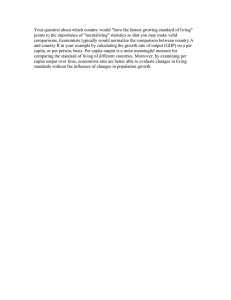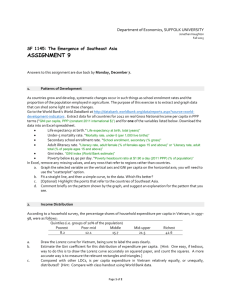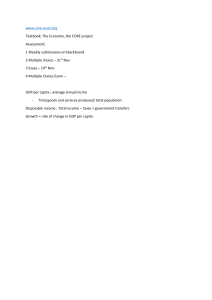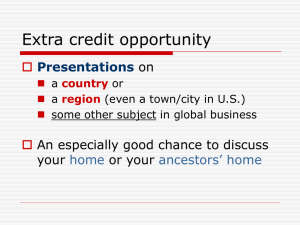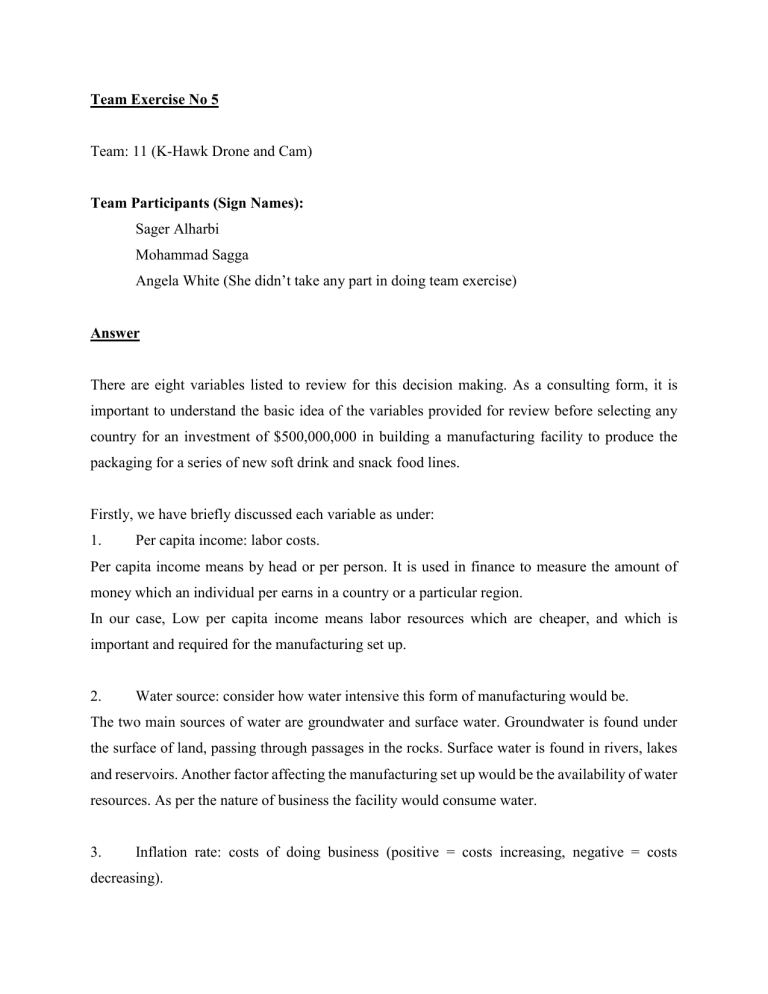
Team Exercise No 5 Team: 11 (K-Hawk Drone and Cam) Team Participants (Sign Names): Sager Alharbi Mohammad Sagga Angela White (She didn’t take any part in doing team exercise) Answer There are eight variables listed to review for this decision making. As a consulting form, it is important to understand the basic idea of the variables provided for review before selecting any country for an investment of $500,000,000 in building a manufacturing facility to produce the packaging for a series of new soft drink and snack food lines. Firstly, we have briefly discussed each variable as under: 1. Per capita income: labor costs. Per capita income means by head or per person. It is used in finance to measure the amount of money which an individual per earns in a country or a particular region. In our case, Low per capita income means labor resources which are cheaper, and which is important and required for the manufacturing set up. 2. Water source: consider how water intensive this form of manufacturing would be. The two main sources of water are groundwater and surface water. Groundwater is found under the surface of land, passing through passages in the rocks. Surface water is found in rivers, lakes and reservoirs. Another factor affecting the manufacturing set up would be the availability of water resources. As per the nature of business the facility would consume water. 3. Inflation rate: costs of doing business (positive = costs increasing, negative = costs decreasing). Inflation rate is an increase in the consumer price index, means it is an overall increase in the general price level of goods and services in any economy, country over a period of time. Another factor is inflation rate, which would decide and regulate the rate of wage hike, which would eventually affect the budget. 4. Land: a proxy for real estate availability and prices. Land is another resource which is required to start a business. Agricultural land would be determined by the availability of raw materials for the manufacturing set up. 5. Stability of financials: reliability of formal institutions and assessment of risk. Financial stability is the situation or state in which the financial market or system is fit to operate smoothly and is unaffected by the economic shocks. Stability here would mean that there will be easy access to capital and will be able to carry out business easily. 6. Tax rate: how does this impact Unicola's profit margins. Tax rate is the ratio which a person or business needs to pay as they are taxed. It is the corporate tax which will decide and evaluate as to how profitable will the venture be. 7. Forest area: Another proxy for land availability and potential materials (?). Forest area is the geographical area covered with forest and woods and that has been declared by the government as forest. Forest area here would determine what affect will the environment have on the work. It will also determine how this resource can be utilized. 8. Energy imports: energy costs (consider how energy intensive the plant will be) (negative = energy exporter, lower prices?; positive = energy importer, higher prices?). Energy imports means the amount of energy that a unit or economy must import depending upon the requirement. Here, imported energy is the expensive energy which would mean depending on another country. This might affect the stability of the project and there would be more risks and uncertainties Based on our analysis in view of above factors, we had narrowed down to five countries i.e. Bangladesh, India, Indonesia, Pakistan and Vietnam. These countries have the lowest per capita income, fair value of improved water source, agricultural land percentage is good, banking stability is almost similar, corporate taxes are in almost same range, greater forest area availability except Bangladesh and Pakistan, and net energy import is very well within control. After narrowing down to these five countries, it was important to decide which are few crucial factors that need to be considered to choose final two countries. Out of all variables, per capita income with highest importance, improved water source, agricultural land percentage and net energy import were given the crucial importance. Further narrowing done was done based on these variables. We decided to divide the five options in two groups. Bangladesh, India and Pakistan were kept in one group since they share border and form a certain area of Asian market. Out of these countries, India emerged as the final choice considering its overall visibility with 86% improved water source, 60.8% of land area is agricultural land, net energy import in only 19% and the most important factor per capita income is low at $720, which means we shall get cheaper labour and workforce not only for construction but for running operation and maintenance as well. There is one external factor which motivated us to choose India is the consumer market. With over 1.3 billion population, India offer as great consumer base. India has been a very open market for foreign investors. The trade policies, cheaper, and skilled manpower with huge consumer base makes it one obvious choice. Vietnam and Indonesia were kept in second group for decision making. Both countries have almost similar traits except a visible difference in per capita income. Based on final four factors i.e. per capita income, improved water source, agricultural land percentage and net energy import, Vietnam emerged to be the final selection for two very important reasons: 1. Vietnam per capita income is $620 against Indonesia’ $1280, 2. Vietnam is connected by land with Cambodia, Laos, Myanmar, Thailand, Malaysia and Singapore, which will give greater stability in distribution of finished product. Indonesia is connected through sea to other countries, making it a less popular choice. Vietnam will benefit us in terms of cheaper manpower and greater connectivity for finished product distribution.
